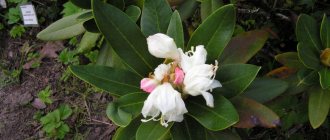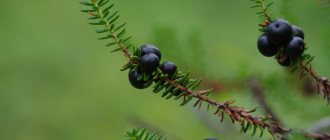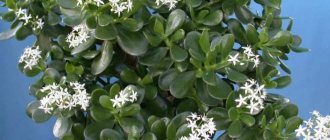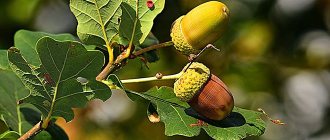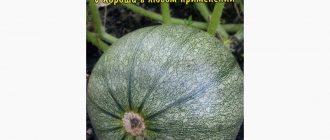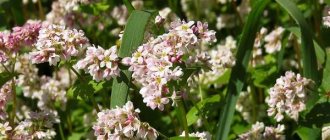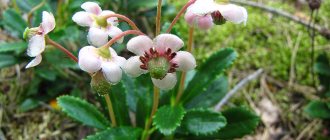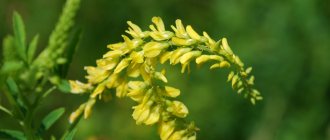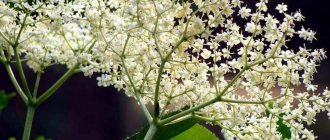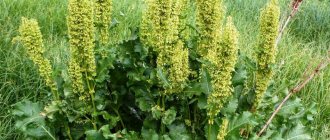Meadowsweet is a perennial plant of the Rosaceae family. Straight, smooth stems are dark green with a reddish tint, densely leafy, can grow up to a meter, and in favorable conditions, more.
The leaves are alternate, pinnately dissected, indeed similar to elm leaves with a serrated edge, which is why meadowsweet got its name. The leaf blade is bare, dark green on top, covered with delicate whitish pubescence below.
The creeping rhizome is characterized by rapid growth. Its average annual growth is about 15 cm, but the larger the plant, the more impressive the growth. Therefore, meadowsweet plants are able to quickly take over all the free space around them.
Natural forms of meadowsweet have small pale yellow or cream flowers, collected in loose paniculate inflorescences up to 20 cm long at the ends of the shoots.
The round buds of the plant are beautiful, the open flowers with many long stamens are delightful
The flower, like all Rosaceae, consists of five petals. Meadowsweet blooms from June to early August. During flowering, it looks especially beautiful thanks to the mass of openwork inflorescences. It is not for nothing that, according to ancient legend, on the shore the sea foam that rolled off the beautiful body of Aphrodite turned into meadowsweet.
On a hot day, they exude the aroma of honey, vanilla, and almonds, which can be felt from afar. Above the white fluffy panicles of meadowsweet flowers you can always hear the buzzing of hardworking bees and bumblebees; the nectar attracts a variety of butterflies and beetles. But mosquitoes cannot stand its smell.
The seed capsules of the fruit, consisting of 10-15 leaflets, harden as they ripen and twist in a spiral. Seeds ripen in August - September
Meadowsweet - beneficial properties
The chemical composition of meadowsweet and its beneficial properties are directly related. Meadowsweet grass is a source of vitamins A, E and C. The root of the plant contains flavonoids, starch, phenols, tannins, and chalcones.
The aerial parts of meadowsweet contain essential oils, steroids, fatty acids and catechin. In 1838, the Italian scientist R. Piria found spiraic acid in meadowsweet, a substance that is a natural derivative of salicylic acid. A little later, scientific technology for the synthesis of acids was developed as a result of which the world received aspirin.
And recently, several nutrients have been identified from the roots and seeds of meadowsweet - spriamine and spriatin. In their effect on the body, they resemble camphor and caffeine, but pressure does not increase, which very effectively protects brain cells from lack of oxygen.
Vyazolistny, Kamchatsky, Khlopalsky and Shestlipestny and others - many different types of meadowsweet are known in nature. All of them have medicinal properties to one degree or another. It is known for sure that Meadowsweet Kamchatka is used to treat liver and gastrointestinal diseases. Six-petalled is used as a wound-healing and antibacterial agent. The most common is Meadowsweet, used in folk medicine, and is also included in some formulations of official medicine.
Recipes for using meadowsweet
To use meadowsweet for medicinal purposes, decoctions, infusions, ointments, and tea are made.
Meadowsweet infusions
Meadowsweet infusion is very useful for patients with diabetes. It lowers blood sugar levels.
Infusions are used in the treatment of rheumatism, hemorrhoids, choking, insomnia, hernia, thrush, infertility, bleeding, psoriasis, anemia, diarrhea, mastopathy, gastrointestinal diseases, etc.
- You can prepare an infusion from meadowsweet rhizomes. For this, 1 tsp. rhizomes need to be poured 250 ml. boiled water, but it should be cold. It should infuse for eight hours. Take small sips throughout the day.
- To prepare an infusion of meadowsweet, you need 1 tbsp. Pour 1.5 liters of boiling water over the herbs and sprouts and leave to steep overnight. This infusion is used 4 times a day, 50-60 ml. before meals.
- Infusion of Kamchatka meadowsweet 1 tbsp. dry crushed herb must be poured with one glass of boiled water and left to infuse for 2 hours. Use 4 times a day, 50 ml.
Meadowsweet decoctions
A decoction of meadowsweet roots is used for malignant tumors, nervous diseases, epilepsy, and hypertension.
Decoctions of meadowsweet herb are also good for washing your hair; it accelerates hair growth.
It is also used in the form of douches. For this purpose 25g. meadowsweet is poured with 1 liter of water.
To prepare the decoction you need:
- Pour 5 g of meadowsweet rhizomes with a glass of boiled water and cook for another 15 minutes.
- Then you need to cool and strain.
This decoction can be used to wash purulent wounds, snake bites, and also to douche.
A decoction of meadowsweet can be prepared as follows:
- 1 tbsp. Add crushed dry leaves to one glass of water and boil for another four minutes.
- Leave for 2 hours and strain.
Use warm decoction half a glass three times a day.
For toothaches, boiled meadowsweet leaves can be applied to the tooth. Because they have analgesic properties.
Tincture for compresses
The tincture is used to treat wounds, ulcers, and skin diseases. It is also used for hormonal imbalance, goiter, and other female diseases.
Preparation of tincture:
- dried grass must be poured with vodka (1:5, respectively).
- Leave for 5 days.
- Mix 50 g of meadowsweet flowers, 1 liter. vodka, 20 g sugar.
- Leave for 12 days.
Drink the tincture three times a day, 30 drops. It is useful for stomach diseases.
Flower tea
Brew tea from meadowsweet flowers:
- 1 tsp per 1 glass of boiled water.
- Leave for 5 minutes.
This tea strengthens the immune system and is also used as a diuretic.
Meadowsweet ointment
Used for rheumatism and various skin diseases. Meadowsweet ointment can be prepared from the herb, as well as from the rhizomes of the plant.
To prepare the ointment you need:
- Grind 20 g of rhizomes until you get a powder.
- Then mix the powder with 90 g of butter (or Vaseline or lanolin).
Apply ointment 3-4 times a day.
Origin
The first mention of meadowsweet by our ancestors occurred in the 11th century. This plant was mentioned in the epic “Sadko”. And it was also noticed in other cultures, for example, shamans in the Finno-Ugric tribes used it to perform their pagan rituals, the Nogais used this plant for knitting ritual whips, which they used as a talisman against the devil.
During the summer holiday Uryus, Kalmyks also wove amulets from meadowsweet and placed them in the bed. Celtic monks also did not ignore this plant and used it in their rituals; they believed that meadowsweet decoctions could remove a large belly. Due to the numerous mentions of meadowsweet in different peoples and countries, the exact place of its discovery could not be established.
Homeland of meadowsweet
To date, botanists have managed to find 90 species of meadowsweet; many of these species can be radically different from each other, for example, being herbaceous or shrubby plants.
And they can also have a variety of leaf shapes, which can be reflected in their name, for example: meadowsweet, birch leaf and others.
Where to plant meadowsweet and how to care for it
Following the descriptions, we can conclude that meadowsweet is best planted in open, illuminated areas. Only slight shade is allowed; the plant will not bloom in complete shade. Choose well-moistened places with non-acidic and permeable soil.
Meadowsweet has a hard time withstanding dry periods; at this time it is advisable to water the flower frequently and abundantly, but remember, it also does not like stagnant moisture. In normal weather, watering is carried out once a week.
Meadowsweet grows in one place for quite a long time; we recommend replanting no earlier than after 6 years. The rhizome of meadowsweet grows upward; it is advisable to add fertile soil or organic mulch so that the roots are not exposed.
There is no need to build any shelters for the winter - the plant has a very high resistance to frost. The only thing you need to do in the fall is cut off the shoots. During the growing season, it is advisable to feed the bushes a little with organic matter; 1 or 2 sessions are enough.
Sometimes cultivated meadowsweet plants are affected by aphids or wireworms, as well as powdery mildew or rust. Any traditional methods widely presented on our website “ECOgarden for everyone” are suitable for plant protection.
To prevent the meadowsweet from spreading, blocking neighboring plants and growing as a lush bush, plant it in a container or limit the planting hole with roofing felt / non-fabric.
Meadowsweet (meadowsweet) and its species
It is mainly found in the temperate zone of the Northern Hemisphere. These rosaceous herbs can reach large sizes.
They have feathery leaves, an erect stem and powerful roots. The leaves, collected in paniculate inflorescences, are usually white or pink.
The calyx of meadowsweet consists of five or six petals without a subcup. Meadowsweet usually blooms in early summer.
The fruits can be seen by the middle or end of summer in the form of multi-nuts. Basically, these plants are resistant to moisture and cold.
Photo of meadowsweet
There are more than 15 species of meadowsweet in nature.
Here are some of them:
- meadowsweet (grows in the Khabarovsk Territory, Kamchatka, Primorye);
- narrow-lobed meadowsweet (found in northern China, the Far East);
- red meadowsweet (found in North America);
- Kamchatka meadowsweet (found in Kamchatka, Japan, Kuril Islands);
- steppe meadowsweet (grows in the Volga region, the Southern Urals, and Siberia);
- meadowsweet (grows throughout Europe);
- meadowsweet (widespread in Russia and the Caucasus) It is found in forests, along the banks of streams and in places with high humidity.
However, few people know that meadowsweet is not only a beautiful ornamental plant.
Many species of this plant have healing properties. They can treat many diseases.
Healing types of meadowsweet include:
- meadowsweet;
- palmate meadowsweet;
- Kamchatka meadowsweet;
- six-petalled meadowsweet.
Application in landscape design
Meadowsweet is often used in the garden in single and group plantings. The use of meadowsweet in combination with other ornamental garden plants gives the flower garden the effect of airiness and misty haze. Very bright flowers are diluted with delicate “cloudy” inflorescences of white and pink meadowsweet. Tall varieties are used as hedges along a fence or around the perimeter of a house.
Kamchatka meadowsweet, common meadowsweet, purple meadowsweet, and other species and varieties are actively used in landscape design in the design of flower beds, borders, and mixborders.
Among garden plantings, meadowsweet goes well with lilies, ferns, astilbe, hydrangea, marigolds, Siberian iris, carnations, and peonies.
Meadowsweet looks great along the banks of artificial reservoirs. In addition to its beautiful, surprisingly airy appearance, meadowsweet fills the garden plot with a delicate honey aroma and serves as a valuable addition to the gardener’s “green” first aid kit.
Description
In appearance, meadowsweet resembles a tall steppe grass or, depending on the species, it can be a subshrub. The height of meadowsweet shoots, as a rule, ranges from 15 to 80 cm. And some species can grow up to 2.5 meters! The straight rods are smooth to the touch and covered with brown bark. Depending on the type, shoots can either spread along the ground or go up. The leaves resemble raspberries in appearance, but are longer in shape.
By the end of the first month of summer, lush and paniculate inflorescences begin to bloom on the shoots. They consist of a large number of small flowers of snow-white or cream color. If you take the corolla of the inflorescence separately, you can see that it consists of many flowers, the corolla itself does not exceed 1 cm in diameter, and the inflorescence itself can reach 15 cm. Thanks to the multiple number of stamens, it looks fluffy and thick.
Meadowsweet shrub
The sweet aroma of meadowsweet cannot be confused with anything; it has notes of honey, vanilla, and almonds. Active flowering of meadowsweet lasts one and a half to two months and depends on the characteristics of the region, and re-blooming can begin in August. Upon completion of the pollination process, fruits appear that look like leaflets with seeds wrapped in them, are 1–2 mm long and dark in color.
The root system of meadowsweet looks like this: one large curly root, and thin shoots grow from it. An independent plant can begin to develop from these shoots, forming new bushes.
Chemical composition
Experts were able to study in detail the composition of meadowsweet:
- flavonoids – quercetin, kaempferol;
- polyphenolic compounds – ellagic, caffeic acid;
- glycosides - monotropitin, spirein, and isosalicin;
- tannins;
- heparin;
- glycerides of stearic and linoleic acids;
- ascorbic acid;
- essential oils.
The oil contained in meadowsweet has a pronounced honey aroma. It contains vanillin, ethyl benzoate, methyl salicylate and other substances that have a positive effect on a person’s overall well-being.
Let's take a closer look at each component, as well as the effect that these substances can have on the body:
- Phenols.
They have analgesic, choleretic, antiseptic effects. They have a mild sedative effect. They also remove excess fluid from the body and stabilize blood pressure. - Salicylic acid.
Has an antiseptic, anti-inflammatory effect. Reduces pain by acting directly on nerve endings. - Flavonoids.
Scientists have been able to establish that the substances have an anti-allergenic effect, they also effectively fight viruses, remove toxins and excess water from the body. In addition, there is a version that these compounds have an anticarcinogenic effect (prevent the development of cancerous tumors). - Kakheti.
They prevent the aging process because they promote the release of free radicals. In addition, they prevent cell aging, triggering regeneration processes in the body, and prevent the development of cancer. - Phenolcarboxylic acids.
Eliminate inflammatory processes in the body, activate the activity of the bile ducts, and promote the excretion of bile. They have a beneficial effect on the functioning of the liver and kidneys. - Essential oils.
They have a sedative, bactericidal, antiseptic effect. They are useful for literally all systems of our body: cardiovascular, nervous, gastrointestinal tract. They prevent and treat coughs by removing mucus from the bronchi. - Glycosides.
They dilate blood vessels, have a disinfectant, diuretic, laxative, and vasodilator effect.
We advise you to read: Tea - what it is, main types, tastes, differences between varieties, brewing
Medicinal properties of meadowsweet
Meadowsweet owes its healing properties to its composition. It contains a large amount of ascorbic acid, salicylic acid, and tannins.
Flowers, roots, and leaves of meadowsweet are used for medicinal purposes. Meadowsweet leaves need to be collected and dried during flowering. The composition of the stems and leaves includes catechins, phenolcarboxylic acids, essential oils and fatty acids. Meadowsweet roots contain phenol glycosides, flavonoids, and chalcones.
Each component in meadowsweet has its own healing properties. Let's look at each of them.
- Vitamin C (ascorbic acid) improves immunity, eliminates inflammation, improves emotional state, and is also involved in the biosynthesis of corticosteroid hormones.
- Tannins have hemostatic, antioxidant and astringent properties.
- Salicylic acid prevents tissue swelling by normalizing capillary permeability. Prevents inflammation by stopping the biosynthesis of prostaglandins, which accelerate the inflammatory process.
- Catechins prevent the development of cancer by neutralizing free radicals. They slow down the aging process of the body by acting on bacteria that destroy cells.
- Phenolcarboxylic acids eliminate inflammation, strengthen the kidneys, and remove bile.
- Fatty acids improve metabolism and have a good effect on the process of energy formation.
- Essential oils are good for the bronchi, they soften coughs, participate in the secretion of mucus from the bronchi, improve the functioning of the cardiovascular system, and improve the functioning of the gastrointestinal tract.
- Phenolglycosides have diuretic, sedative, expectorant, disinfectant, laxative, and antimicrobial properties.
- Flavonoids have antiulcer, antispasmodic, antiviral, choleretic, antioxidant, anti-inflammatory, antiviral properties.
We can conclude that meadowsweet herbs have a number of useful medicinal properties:
- antipyretic;
- diaphoretic;
- antibacterial;
- anti-inflammatory;
- choleretic;
- diuretic;
- antitumor;
- pain reliever;
- tonic;
- anthelmintic;
- astringent.
Kinds
There are many varieties of plants found in nature, let’s consider them in detail.
- Aurea.
It belongs to the garden form and has incredibly beautiful yellow-green leaves. - Rosea.
This species has beautiful pink flowers. Rarely found, considered a hybrid. - Plena.
Has a large number of white double flowers. The plant is tall, the shoots are bare at the base - at this point gardeners consider it a disadvantage. - Aureovariegata.
It has an unusual appearance - there are golden streaks on the leaves. To emphasize this feature, experts recommend growing meadowsweet in sunny areas of the garden. - Filipendula camtschatica.
The plant is tall, has large leaves - up to 40 cm in length. The stems have large inflorescences of cream or white flowers. Begins to bloom in mid-June. Loves moisture, grows well both in the shade and in the sun. - Red meadowsweet.
It grows in areas of North America, where it is called the queen of the prairies. Powerful, tall, has a five- or seven-lobed lobe. It begins to bloom at the end of July, the inflorescence is quite dense, consisting of pink flowers. Loves light and high humidity. Resistant to frost. - Common meadowsweet.
Can reach 1 m in height. It has large flowers - up to 1 cm, the color varies - cream, white or pink. It usually blooms at the end of May. It has an attractive appearance even after flowering. Does not require a large amount of moisture, unpretentious. - Purple meadowsweet.
It is a hybrid and is very popular in Japan - it is used as an ornamental plant. It is low, the maximum height reaches 1 m. The leaves are beautiful, palmate. The flowers are dark pink or purple; the fruits have clearly visible stems, which are usually not fully developed. - Elegans.
It begins to bloom at the end of July, it has beautiful white flowers with red stamens. - Korean meadowsweet.
Grows in the Southern Kuril Islands, Japan, and the south of Primorsky Krai. The plant is not tall, but graceful. It is noteworthy that the flowers are pink in color when they are in bud; when they bloom, they turn white. - Meadowsweet polypairous.
They are divided into two forms - alpine and forest. The latter species can be found along the banks of streams, it reaches 80 cm in height, has beautiful leaves - pinnate, finely cut. The flowers are bright pink. The alpine type of meadowsweet can most often be found in the highlands; the plant is low (about 30 cm), the leaves are small. - Meadowsweet narrow-lobed.
The plant has unusual leaves - they are thinly dissected and covered with white-tomentose lower parts. Can be found in the south of the Amur region, meadowsweet often hybridizes. - Western meadowsweet.
Grows in forests and on rocky shores. Grows up to 1 m, has graceful rounded leaves. The fruits are ciliated and hairy, the flowers are white and can reach 1.5 cm in diameter. - Kirasian meadowsweet.
It is a rare species and can only be found in Taiwan, in the northern part. Maximum height – 30 m, pink inflorescences, small. It is noteworthy that the plant is polygamous; bisexual flowers can be found: both male and female. - Tsugovo.
A not fully studied species, it looks similar to the Kirassian meadowsweet, but it does not have bisexual flowers. The flowers are white. - Filipendula formosa.
It grows up to 1 m tall, the leaves are round, the inflorescences are dark pink. Poorly studied by specialists, it is rare - literally a dozen herbarium specimens can be found all over the world. - Steppe meadowsweet.
Outwardly similar to meadowsweet, the maximum height of the bush is 1 m, has a dense basal rosette of leaves, which persists during the flowering period. Considered a rare species.
We recommend reading:
medicinal properties of the herb colza Read
Collection and storage
It is necessary to collect flowers during the flowering period - usually the end of July or the beginning of August. The inflorescences should be cut without leaves, and dried in a well-ventilated place, first spread out in a thin layer on parchment (experts do not recommend using newspapers, since harmful ink can poison the workpiece). Store in a box in a dark and dry place.
We advise you to read: Blackberries: benefits and harms, medicinal properties and contraindications for women and men
The roots of the plant are also harvested. They need to be collected either in early spring or autumn. Before drying, remove soil and rinse thoroughly under running water. They are dried in the same way as flowers - laid in a thin layer on paper, left in a well-ventilated area, in the shade. If you plan to use the leaves for medicinal purposes, they also need to be harvested during the flowering period of the meadowsweet. The shelf life is 3 years, then the grass gradually begins to lose its beneficial properties.
Harvesting meadowsweet
Whitecap flowers are usually collected as medicinal raw materials. The best time to collect is July-August, the period of mass flowering. The panicles are cut to the first leaf and dried in the shade in a draft at a moderate temperature.
Raw materials should be stored in a tightly closed box. Properly prepared raw materials will be brown in color, have a characteristic odor and a bitter-tart taste.
If you need to prepare meadowsweet roots, it is better to dig them up in the off-season. Freeing the rhizomes from the soil and stems, they are washed in cool water, cut into pieces of 10-15 cm and dried under the same conditions, laid out in a layer of up to 1 cm on cloth or paper.
Can be stored in bags or containers made of wood or glass. The shelf life of this product is 3 years if stored in a cool, dry place.
Planting meadowsweet in open ground
Priming
Meadowsweet is not particularly demanding on the composition of the soil. However, it grows best in neutral nutrient soil. If the soil on the site is acidic, then before planting the shrub it is recommended to add wood ash or lime to it. Also, when digging a site, it is advisable to add compost or humus to the soil.
The plant also prefers well-drained soil. Therefore, if the soil is heavy, then sand should be added to it.
Selecting a location
To grow meadowsweet in open ground, it is best to choose an area with moist soil, but the water should not stagnate on it. If the groundwater lies very close to the surface of the site, then it is recommended to make a high bed for the shrubs and not forget about a thick layer of drainage.
An area suitable for such a plant may be slightly shaded. Please note that it cannot be grown in the shade. It is best for him to choose a sunny, open place or an area that will only be slightly shaded by plants growing nearby.
Plant care
Ornamental meadowsweet is a moisture-loving plant that requires regular watering; the soil around the bush must be kept moist. Because of this feature, the plant is planted in lowlands, around artificial reservoirs, and regular watering is provided. Kamchatka, red, elm-leaved and steppe are very moisture-loving varieties of meadowsweet. With prolonged high air temperatures and hot weather in summer, leaves may wilt and buds may fall off. This occurs due to overdried soil. The problem is solved by watering, literally after a while the plant comes to life.
Organic and mineral fertilizers are used as fertilizers, which are applied to the soil 1-2 times during the growing season.
The plant does not require fertilizing; its absence will have virtually no effect on the appearance of the bush.
Caring for meadowsweet is not at all difficult; maintaining the good condition of the bush consists not only of watering, but also of periodically destroying weeds and loosening.
At the end of August and September, after the flowering period, the bush loses its decorative appearance, so it is pruned, leaving 5-10 cm. Shelter for the cold period of the year is not required; meadowsweet is a fairly winter-hardy plant. After planting meadowsweet, caring for new plants consists of creating comfortable conditions for good growth and development. In the first days, wood ash or lime is added and supports are installed, otherwise, as the stems grow, they may not support the weight of the flowers, break or lie on the ground. Water the plant regularly; the soil around the plant should be constantly moist. An exception to the rule is the common meadowsweet; it is drought-resistant, prefers dry, light soils, and does not need regular watering.
Indications for use
Antitumor collection Zdrenko
In folk medicine, various preparations with meadowsweet are used to eliminate all kinds of health problems. For example, meadowsweet root is part of the famous Zdrenko collection, which contains 35 species of medicinal plants.
This collection is antitumor, which does not interfere with its use in the treatment of diseases of the gastrointestinal tract, anemia, hemorrhoids, prostate adenoma, uterine fibroids and other ailments.
The scope of application of products obtained from different parts of the meadowsweet depends on the form in which the drug is presented and what raw materials were used for its manufacture.
Root decoction
To prepare, take 1 tsp. crushed dry raw materials, per glass of boiling water. A decoction of meadowsweet rhizomes is prepared in a water bath for half an hour, and after that it is infused and filtered for an hour.
The drug is suitable for both internal use and douching (for intestinal disorders and hemorrhoids). For the treatment of rheumatism, nervous diseases, gout, kidney diseases, the recommended dosage is 1 tbsp. l. after every meal.
Decoction for oncology and leukemia
In the complex treatment of cancer, you can use a decoction of meadowsweet; it will strengthen the body and improve blood composition. The recipe looks like this:
- dry meadowsweet roots are crushed in the amount of 2 small spoons;
- pour a glass of boiling water into an enamel pan;
- cook for about half an hour in a water bath, and then leave until cool.
The strained product is taken 3 large spoons on an empty stomach three times a day. The duration of the course is 3 weeks.
Important! To use meadowsweet in folk medicine for oncology, you need to ask your doctor’s permission and combine the plant with official medications.
Decoction for diarrhea
For diarrhea, traditional medicine recommends preparing the following decoction:
- a large spoonful of crushed meadowsweet leaves and seeds is poured into 200 ml of liquid;
- keep in a water bath for about 15 minutes;
- leave covered for an hour.
You need to drink 2 large spoons of the decoction after each attack of diarrhea. Treatment with meadowsweet continues until the symptoms disappear.
Water infusion
Recommended for a whole list of ailments:
- psoriasis;
- leukemia;
- hepatitis;
- insomnia;
- bladder and kidney diseases;
- bleeding;
- diabetes;
- inflammation;
- swelling;
- hernia;
- diarrhea.
To prepare a water infusion of meadowsweet, you need to take 1 tsp. dry inflorescences and pour a glass of boiling water over them. Infusion time - until completely cooled. The infusion should be consumed throughout the day in small portions.
Ointment
The drug is intended for external use. The ointment can be used to treat rheumatism and skin diseases. To prepare it, you need to grind 20 g of dry meadowsweet rhizomes into dust and mix with 80 g of a fat base (lanolin, petroleum jelly, butter).
The ointment is applied to the affected skin. Also, it is rubbed into sore joints for arthrosis, arthritis, rheumatism and other joint diseases. For the best therapeutic effect, it is better to carry out the procedure at night, remembering to wrap the joints with a scarf or shawl.
Tea
The health benefits and harms of meadowsweet tea are used in the prevention of colds. Making the drink is very simple:
- Brew 2 large spoons of finely chopped leaves in 1 liter of boiling water for 15 minutes;
- add a spoonful of natural honey;
- Drink tea throughout the day at intervals of 2-3 hours.
If you wish, you can simply add a pinch of dried meadowsweet flowers or leaves to regular teas - green, black and herbal. For example, fireweed tea with meadowsweet has good immunomodulatory properties.
Alcohol tincture
To prepare it you will need freshly picked meadowsweet inflorescences in the amount of 25 g, 10 g of sugar and 0.5 l of alcohol. All ingredients are mixed and left alone for exactly 12 days. After this time, the tincture is filtered and taken as directed: for the treatment of gastric diseases - 20 drops per glass of water (no more than three times a day).
Also, this drug is suitable for external use: it can be used to treat trophic ulcers, purulent wounds and burns, but only the alcohol tincture must first be diluted with water.
Antiviral tincture of calendula vodka with meadowsweet: application
If you take an antiviral tincture of calendula and meadowsweet every day, then you will not be afraid of any viruses.
Tincture of calendula and meadowsweet
Recipe:
Ingredients:
- Dried meadowsweet flowers
- Yarrow tincture – 5 ml
- Water – 200 ml
Preparation:
- Pour meadowsweet flowers into the cup until it is half filled.
- Pour lukewarm boiled water into it. Leave this drug to infuse under the lid for 12 hours.
- Add 50 ml of calendula tincture to your drink.
- After 3-4 hours, strain the infusion and carefully squeeze out the flowers.
- You should drink the panacea every day during epidemics, three times a day (1/2 tsp).
Meadowsweet root, medicinal properties and proper use
All parts of the plant can be used for treatment, and meadowsweet root, the medicinal properties of which are almost as good as the beneficial qualities of flowering, can be used against many ailments. Usually, products based on it are used against high blood pressure, gout, and kidney diseases.
Preparation of the product:
- Wash and grind 15 g. dry rhizomes.
- Pour boiling water (500 ml) over the prepared plant material and place in a water bath.
- Let the mixture sit for about half an hour at a low boil.
- Infuse the product for an hour, be sure to leave the lid closed.
- Strain and add boiled water to the original volume.
Take the product three times a day, only 25 ml at a time. It is recommended to do this only after eating. You can add a small amount of sugar or diversify the taste with good honey.
We advise you to read: Horsetail decoction - a universal forgotten medicine
Ointment from the rhizome can be used to treat wounds, burns and all types of dermatitis. It’s easy to prepare – grind the roots into powder (20 g), mix with butter (90 g). Use the product for rubbing or compresses several times a day. You can also use it to affect sore joints, but it is better to do this after prior consultation with your doctor.
We recommend reading: Cuff grass - medicinal properties, contraindications, application
Meadowsweet, whose beneficial properties and contraindications are so diverse, is not in vain considered one of the most popular plants in folk medicine, because this herb can cope with a considerable number of diseases. You should not avoid the wonderful effects - even simple tea will have a beneficial effect on your health and improve your well-being.
How to use meadowsweet extract for aging facial skin?
In order for your skin to regain its former elasticity and become radiant and youthful again. Use an ointment with meadowsweet oil externally and a decoction with the leaves of this plant internally. It is enough to apply the ointment only once a day in the evening. And you should drink the drug in the morning before eating.
Application of meadowsweet for facial skin
IMPORTANT : Before using a medicinal plant, be sure to read the contraindications.
What diseases does it help with?
Meadowsweet has a wide range of uses; it is used in medicines ranging from a banal cut to serious illnesses of the body. An infusion of flowers is used to relieve swelling and treat metabolic disorders, is used as a diuretic and diaphoretic and a mild pain reliever for pain in the stomach or intestines.
When adding calendula tincture, it is used for the treatment and prevention of viral diseases such as influenza, sore throat, ARVI, etc. An infusion of meadowsweet herb has an anti-inflammatory and bactericidal effect and is applied externally to skin lesions. An infusion of meadowsweet seeds is used in medicine to restore the body after a stroke.
Powdered meadowsweet leaves are used as a powder to treat burns and bedsores. An ointment with the addition of such powder treats skin diseases such as psoriasis. It is important that in oncology, meadowsweet is used in a general strengthening herbal collection to support the body after chemotherapy.
Meadowsweet in gynecology
To help women fight inflammatory processes, it is necessary to prepare an infusion of meadowsweet. This remedy is taken in small portions per day. To prepare, you need to take one spoon of dry herb and one glass of boiling water, let the product sit in the dark for a day.
To solve the problem of infertility, meadowsweet should be combined with linden and red clover (3 tablespoons of each). Dilute the mixture with one liter of boiled water, let it settle and take a glass twice a day.
To prevent uterine bleeding and gynecological ailments, it is necessary to use crushed dried herb root, which should be infused with vodka (up to a week). Drink this remedy twice a day (not exceeding one teaspoon), combining it with 50 grams of vodka.
When treating endometritis and uterine fibroids, you should also use a special collection from the rhizomes of calamus, meadowsweet, chamomile, St. John's wort, juniper berries, calendula and yarrow. Each plant will need one spoon, add one and a half liters of vodka and then infuse for about two weeks.
Herbal tinctures are used for baths, internal use and douching.
Meadowsweet for thyroid problems
Problems with the thyroid gland are based on a lack or excess of iodine in the body. This disease also recedes under the influence of meadowsweet. You just need to prepare a tincture using a bottle of vodka and 50 grams of the plant’s rhizome.
Thoroughly clean the root, rinse, grind, and add vodka. Let the tincture sit for two weeks, stirring every day. A dark place is better for this. When ready, take the product one spoonful on an empty stomach.
The course of treatment is quite long, eight bottles of tincture are needed, and there is a need to take a break. Even if it takes a lot of time, the main thing is to get the expected result.
Meadowsweet for pressure
The herb is a truly powerful remedy in the treatment of hypertension, which acts quickly and effectively against the disease. To do this, drink tea prepared in a water bath for fifteen minutes. For one large spoon of dry herb, you will need half a can of boiling water, let it stand for one hour.
The course will be one month, drink on an empty stomach three times a day. Chopped meadowsweet root, prepared in a water bath, will help cope with high blood pressure; take it in a spoon before meals.
Planting and propagation
Even inexperienced gardeners will not have problems planting and caring for meadowsweet. The plant prefers open sunny glades, but will also grow actively in partial shade. In shady, enclosed areas, the decorative appearance may suffer: flowering will be less lush and bright, or the bush will stop flowering altogether. Any loose, fertilized, moist soil with a good ability to drain excess water is suitable for growing meadowsweet, since the bush does not like excess moisture in the soil. Slightly acidic and neutral soils are well suited; acidic soil is not suitable for the bush.
Meadowsweet reproduces by dividing the bush and by seeds.
Reproduction of meadowsweet
Vegetative propagation, that is, dividing the bush, is suitable for all types of meadowsweet. It is produced in the fall. To do this, select an adult healthy bush, which, after moistening the soil, is dug up and the rhizome is cut into pieces 5-10 cm long. They are planted directly in the soil, making holes 5-10 cm deep, or stored in the refrigerator, buried in wet sand, sawdust or wrapped in damp cloth.
Common meadowsweet is propagated, in addition to rhizome segments, by root tubers, however, when propagated by tubers, the plant does not bloom in the first year of planting. For division, choose bushes no younger than five years old.
When propagating by seed, the seeds are sown directly into the ground or onto seedlings. Most often, when propagating meadowsweet, preference is given to the seed method. Only well-ripened seeds, which easily break off from the receptacle, are collected in the fall. Seeds should be sown in the ground immediately after collection, or you can wait until spring. To preserve the germination of seeds, they are stored in a cool place, but even in this case, the percentage of germination of seeds sown in autumn is significantly higher than when planted in spring. It is necessary to plant meadowsweet seeds in the ground 1.5-2 cm deep. Seeds planted in the fall germinate better. Since the seed shell is quite hard, before sowing, they are filled with water for a day or treated with a growth stimulant. Shoots appear in late April-early May; for better growth and development, young shoots are fed with liquid mineral fertilizers in the second half of May.
Seeds are sown in spring (late March) in seedling containers. Sow the seeds in furrows or evenly scatter them on the surface of the soil without sprinkling them. Then cover the boxes with a transparent lid (glass, polyethylene) and place them in a shaded place. In April, shoots appear, at which point the lid is removed. At the end of June, the grown sprouts are transplanted into moist soil to a permanent place in the garden. For the first 7-10 days, young plants need daily watering, after which the soil is moistened as the soil dries. Caring for young shoots consists of timely loosening, weeding and fertilizing with complex mineral fertilizers twice (in June and July) in the first year of planting. If you follow simple rules for caring for seedlings, the survival rate of seedlings is 90-100%. With the seedling propagation method, flowering occurs in the second year after planting. Seeds planted in the fall are covered for the winter, since young plants may die in the cold season.
Meadowsweet tea, benefits and harms
Most often, meadowsweet tea is used for preventive purposes, the benefits and harms of which were established many years ago. You can safely use the drink against colds - it will significantly alleviate the condition.
Preparation of the drink:
- 15 gr. Pour boiling water (250 ml) over the flowers of the plant.
- Cover the container with a lid and leave for a quarter of an hour.
- Strain the liquid, you can add honey, but not necessarily.
You should drink tea made from this herb only in small sips, and be sure to retain the liquid in your mouth. This will not only allow you to feel an aromatic bouquet of delicious taste, but also have a healing effect on inflammatory processes on the gums or relieve toothache.
Can the drink be harmful? Despite numerous studies, no allergens have been identified in it, so you can consume it without fear. The only thing doctors recommend is not to drink it during pregnancy and with chronic diseases. If you have poor blood clotting, it is also better to refrain from drinking tea.
Diseases and pests
Meadowsweet is resistant to diseases and pests.
Species specimens can occasionally be affected by powdery mildew and rust. For decorative varieties, a rare case is ramularia (leaf blades become covered with greenish spots that dry out over time). Treat with a fungicidal agent (for example, Fundazol).
Among the pests, aphids and tubeworms should be noted. Treatment with an insecticide will help get rid of them. To combat aphids, you can use wood ash, spraying with infusion of onion or garlic.
Contraindications
Meadowsweet herb has almost no obvious contraindications or side effects, if you do not take into account individual intolerance.
There are side effects from some decoctions, tinctures and other derivatives. Meadowsweet tinctures are contraindicated for people with liver disease due to the alcohol content. Those who often suffer from constipation may feel worse when using meadowsweet due to the astringent properties of the herb. It is not recommended to take decoctions for people with low blood pressure; due to meadowsweet, it will drop more strongly, causing weakness, dizziness and nausea.
If used or calculated incorrectly, there may be an overdose, which will lead to stomach diseases and nausea. It is better to first test meadowsweet-based cosmetics on the skin on the wrist. It may cause an allergic reaction.
Sources
- https://ekopiter.ru/spravochnik/labaznik
- https://RasteniyaDom.ru/komnatnye-rasteniya/tavolga-foto-rasteniya.html
- https://NaturDoc.ru/labaznik-lechebnyie-svoystva-i-protivopokazaniya/
- https://polzavred-edi.ru/labaznik-lechebnye-svojstva-i-protivopokazanija/
- https://rastenievod.com/labaznik-tavolga.html
- https://lifestyleplus.ru/trava-tavolga-lechebnye-svojstva-i-protivopokazaniya.html
- https://poleznii-site.ru/lekarstvennye-rasteniya/labaznik-tavolga-lechebnye-svoystva-i-primenenie-protivopokazaniya-chto-lechit-u-muzhchin-i-zhenschin-kak-pit.html
- https://organicfact.ru/trava-tavolga/
- https://travaks.com/tavolga/tavolga-lechebnye-svojstva-i-protivopokazanija/
- https://fitfree.ru/polza-i-vred/labaznik-lechebnye-svojstva-i-protivopokazaniya
[collapse]
